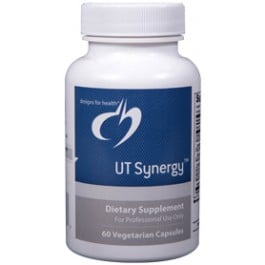
Quick Overview
UT Synergy™ features UTIRose™, a patented, exciting and unique compound designed specifically to support the health of the urinary tract.* UTIRose™ is a...
Cranberry & UTI
By Gene Bruno, MS, MHS – Dean of Academics, Huntington College of Health Sciences

Urinary tract infections (UTI) are no fun— especially for women who are 10 times more likely than men to have a UTI because of anatomic construction of the female urinary system. As a matter of fact, approximately 20% of women have at least one UTI in their lifetime. UTI is often marked by urinary frequency, burning, pain with voiding, and, if the infection is severe, visible blood and pus in the urine. UTI are caused by gram-negative bacteria, most commonly Escherichia coli (E. coli). The best news for anyone who is suffering from UTI, and/or who tends to experience recurrent UTI, is that cranberries are the sworn enemy of UTI.
Cranberry has an extensive history of use for treating UTI. Furthermore, this traditional use of cranberry for UTI has been validated through scientific research. In one study, elderly women who drank 300 ml (10 oz) of cranberry juice per day had a decrease in the amount of bacteria in their urine.1 In another study, elderly residents of a nursing home who consumed either four ounces of cranberry juice or six capsules containing concentrated cranberry daily for thirteen months, experienced a 25% decrease in the number of UTIs during that time.2 The current is that there are two possible mechanisms of action by which cranberry are effective against UTIs. First, cranberry prevents E. coli, the bacteria that cause most urinary tract infections, from attaching to the walls of the bladder.3 Second, at least two of the organic acids in cranberry have been found to have antibacterial activity. These include hippuric acid,4 and citric acid.5 6 This does not mean, however, that cranberry is a substitute for antibiotics in the treatment of acute UTIs. What it does mean is that if you want to prevent and help to treat UTI, you should either drink 300–500 ml (10–16 oz) of cranberry juice cocktail, or take 500 mg of concentrated cranberry extract (Cran-MaxTM), twice daily. As a matter of fact, the latter recommendation may have certain benefits over the former.
Cran-MaxTM is made from the whole cranberry, including the juice, fruit, solids, seeds and skin. Furthermore, it does not contain added sugar. One downside to cranberry juice cocktail is that it does contain added sugar. Not only may the additional sugar present a problem to diabetics and other individuals with blood sugar problems, but it also may potentiate the growth of E. coli. Consequently, the use of the “no added sugar” Cran-MaxTM may be a preferable alternative. Also, Cran-MaxTM contains 12.6% organic acids on a weight/volume basis (including those listed above), while cranberry juice contains 11.1%. Therefore, greater potential antibacterial activity exists with Cran-MaxTM.
In addition to the anti-UTI properties of cranberry, there are other health-promoting benefits as well. For example, cranberry contains another organic acid called ellagic acid. Animal research has shown that ellagic acid was able to inhibit chemically induced cancer in the lung, liver, skin and esophagus.7 Cran-MaxTM contains 1.7% ellagic acid. Cranberry juice contains 0% (w/v).
Another value associated with cranberry is that it contains procyanidin antioxidants, which have numerous potential health benefits associated with their ability to scavenge harmful, oxidizing free radicals. Cran-MaxTM, however, has three times greater antioxidant activity as compared to cranberry juice cocktail. Of course, this isn’t surprising when you that Cran-MaxTM has 82.31% total procyanidins, while cranberry juice cocktail has 67.79% (see chart).
The integration of two Cran-MaxTM capsules daily into your dietary supplement program may be a simple way to reduce UTI, as well as promote other health benefits.
Smart Supplementation™ is a free series of educational literature created by Huntington College of Health Sciences (HCHS) as a public service. Although copyrighted, it may be freely photocopied and distributed, but may not be altered in any way. Smart Supplementation™ is not intended as medical advice. For diagnosis and treatment of any medical condition, consult your physician.
1. Avorn J, et al, JAMA (1994) 271:751–54. 2. Dignam R, et al, J Am Geriatr Soc (1997) 45:S53. 3. Sobota AE, J Urol (1984) 131:1013–16. 4. Bodel PT, Cotran R, Kass EH, J Lab Clin Med (1959) 54:881–88. 5. Yamaguchi M, et al, Journal of endodontics (1996) 22(1):27-9. 6. Siqueira Junior JF, et al, Journal of endodontics (1998) 24 (6) p414-6. 7. Stoner GD, Mukhtar H, Journal of cellular biochemistry. Supplement (1995) 22:169-80.

UT Synergy™ features UTIRose™, a patented, exciting and unique compound designed specifically to support the health of the urinary tract.* UTIRose™ is a...

Due to its crystalline structure, absorption of DIM is minimal when given orally (similar to CoQ10). DIM absorption can be greatly enhanced by...